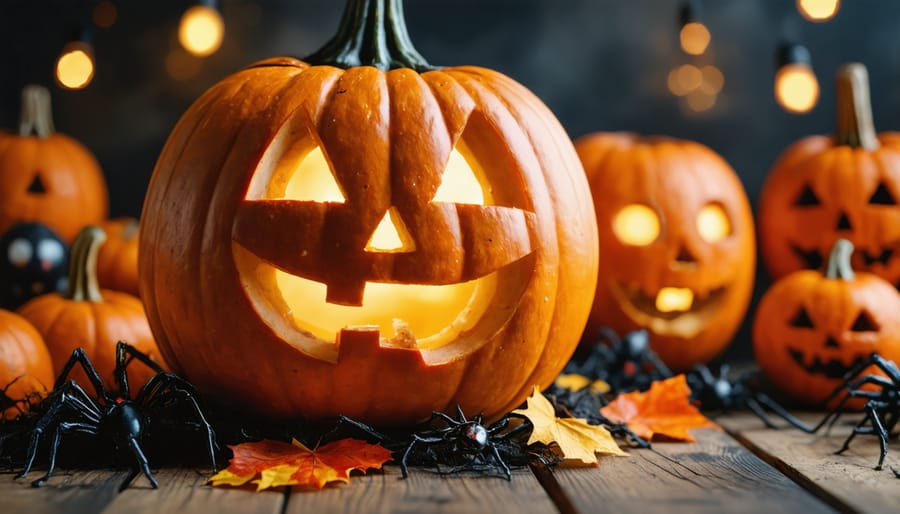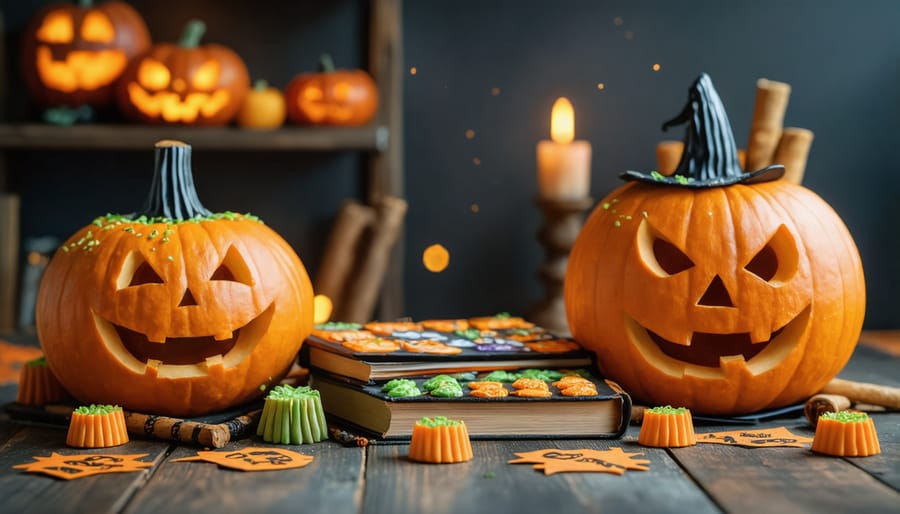Turn Your Halloween Party Into a Trivia Showdown Your Students Will Remember
Transform your Halloween classroom into a learning celebration with trivia activities that balance spooky fun with educational value. **Set up quick 15-minute game sessions** using PowerPoint templates that require zero prep time—simply project questions about Halloween history, vocabulary, or subject-specific content and watch engagement soar. **Customize difficulty levels** by adapting questions to match your grade level, from simple “true or false” formats for younger students to challenging multiple-choice quizzes for older learners. **Organize team-based competitions** that promote collaboration while keeping every student involved—assign point values, use buzzers or hand-raising systems, and rotate team leaders to maintain energy. **Incorporate curriculum connections** by weaving in math word problems with candy corn, science questions about pumpkin life cycles, or vocabulary challenges using Halloween-themed words. These structured activities give you full classroom control while delivering the festive atmosphere students crave, making Halloween both memorable and meaningful without sacrificing instructional time.
Why Halloween Trivia Works When Candy and Costumes Don’t
Let’s be honest—traditional Halloween parties can quickly turn into chaos. Sugar-fueled students bouncing off the walls, costume competitions that leave some kids feeling left out, and that sinking feeling that learning has completely left the building. Sound familiar?
Here’s the good news: Halloween trivia flips the script entirely.
**Classroom Management Made Easy**
Trivia keeps students in their seats and focused on the activity. Instead of managing costume parades and candy distribution, you’re facilitating an engaging game where excitement is channeled into answering questions and competing respectfully.
**Learning Never Stops**
The beauty of trivia? You’re actually teaching while celebrating! Whether you’re incorporating math word problems with Halloween themes, reviewing vocabulary, or exploring the history of Halloween traditions, students are actively learning without even realizing it.
**Truly Inclusive for Everyone**
Not every family celebrates Halloween or can afford elaborate costumes. Trivia levels the playing field—every student can participate equally, regardless of their background or what they’re wearing. Success depends on knowledge and teamwork, not costumes or candy.
**Productive Energy Release**
Kids are going to be excited about Halloween no matter what. Trivia harnesses that energy and directs it toward something constructive. Students get the Halloween celebration they crave while you maintain the structure your classroom needs.
Plus, setup takes minutes, cleanup is minimal, and you can customize questions to match your current curriculum. It’s the perfect win-win for everyone involved.

Ready-to-Play Halloween Trivia Game Formats
Halloween Jeopardy-Style Games
Transform your Halloween review session into an exciting game show experience with a spooky-themed Jeopardy game! This classroom favorite gets a festive makeover with categories that blend seasonal fun with curriculum content.
Start by creating categories that match your learning objectives while embracing the Halloween spirit. “Monster Math” works perfectly for practicing equations, “Scary Science” can cover everything from animal adaptations to chemical reactions, and “Halloween History” explores the holiday’s fascinating origins. Other crowd-pleasers include “Spooky Spelling,” “Frightening Fractions,” or “Creepy Creatures” for biology units.
The beauty of using PowerPoint templates is the built-in scoreboard that automatically tracks points for each team. No more erasing and rewriting scores on the whiteboard! Students stay engaged watching their points accumulate, and you can focus on facilitating rather than scorekeeping. The templates follow traditional Jeopardy game rules, making gameplay instantly familiar to most students.
Customization takes just minutes. Simply replace the sample questions with your own content, adjust point values if needed, and add Halloween-themed images or colors to enhance the spooky atmosphere. You can even include sound effects for correct answers or dramatic reveals!
Divide your class into teams of 3-4 students to encourage collaboration. Designate one student per team as the official buzzer or hand-raiser. This keeps the game organized and ensures everyone participates. Whether you’re reviewing for a test or reinforcing new concepts, Halloween Jeopardy transforms ordinary review time into memorable, engaging learning that students actually look forward to!
Halloween Quiz Bowl Competitions
Transform your classroom into a thrilling competition arena with Halloween Quiz Bowl! This fast-paced format gets everyone involved while reinforcing knowledge across any subject area. The rapid-fire questions and team collaboration make it one of the most exciting team-based review games you can host this season.
**Setting Up Your Teams**
Divide your class into 3-5 teams depending on size—aim for 4-6 students per group. Let teams choose spooky names like “Wicked Witches,” “Hungry Zombies,” or “Midnight Vampires” to boost team spirit. Assign each team a designated area in the classroom and give them 30 seconds to create a team cheer or gesture.
**Running the Competition**
Designate one student as scorekeeper and display points on your board where everyone can see. Ask questions in rotation, giving each team 10 seconds to discuss before answering. Award 10 points for correct answers, but here’s the twist—teams can “steal” questions if another team answers incorrectly for bonus points!
**Keeping Energy High**
Use a Halloween bell or buzzer for time limits. Mix easy and challenging questions to keep all skill levels engaged. Consider adding “lightning rounds” where questions are worth double points, or “trick-or-treat” questions where teams can choose mystery point values. Celebrate correct answers with enthusiasm and keep the atmosphere supportive—every team should feel encouraged throughout the game!

Spooky Wheel of Fortune Trivia
Transform your Halloween lesson into an exciting game show experience with a spinning wheel trivia format! This dynamic activity combines the thrill of chance with curriculum-based learning, keeping students engaged through visual and auditory excitement.
Set up your wheel with different Halloween-themed categories like “Monster Math,” “Spooky Science,” “Creepy Vocabulary,” or “Historical Hauntings.” The spinning motion immediately captures attention, while sound effects—think creaky spins and eerie clicks—build anticipation. When the wheel stops, students answer questions related to that wedge’s subject area.
The visual appeal is unbeatable. Use bright orange and purple sections, add bat or pumpkin graphics, and watch students lean forward in their seats as the wheel rotates. The element of surprise keeps everyone alert since they won’t know which subject comes next!
Customize your wheel to match your current units. Teaching fractions? Add “Fraction Phantoms.” Studying weathering and erosion? Try “Terrifying Transformations.” The beauty is you can adapt content for any grade level while maintaining that festive atmosphere.
Add bonus wedges for extra engagement—”Trick or Treat” spaces where students can steal points or share candy, or “Mystery Potion” sections with surprise challenges. Team play works wonderfully here, letting students collaborate while the excitement of spinning creates natural motivation.
Quick setup tip: Prepare question cards in advance organized by category, so gameplay moves smoothly without interrupting that magical Halloween energy!
Halloween Trivia Questions That Actually Teach
Elementary-Friendly Halloween Questions
Get your younger students excited about Halloween while reinforcing essential skills with these kid-friendly questions! Mix educational content with spooky fun to keep everyone engaged.
**Reading and Vocabulary Fun:**
– What word means a large pot witches use for making potions? (cauldron)
– Can you spell “skeleton” without looking at the word wall?
– What’s the opposite of “day” when monsters come out? (night)
**Math Made Spooky:**
– If you have 5 candy corns and get 3 more, how many treats do you have?
– Count the legs on 2 spiders! (16 total)
– Which is heavier: a real pumpkin or a paper ghost?
**Science Explorations:**
– What do pumpkins grow on—trees or vines? (vines)
– Name the parts of a pumpkin: seeds, stem, and…? (flesh or pulp)
– What season does Halloween happen in? (fall/autumn)
These questions work beautifully for whole-class discussions or small group activities. Customize difficulty based on your grade level—kindergarteners might focus on counting activities, while second graders can tackle vocabulary challenges. Make it extra special by having students draw their answers or act them out for kinesthetic learners!
Middle and High School Challenge Questions
Older students love a good challenge, and Halloween trivia gives you the perfect opportunity to connect the holiday with core curriculum subjects! Try these interdisciplinary questions that make students think deeper.
For English classes, explore Edgar Allan Poe connections: “Which Poe story features a black cat as a central character?” or “What does ‘Nevermore’ mean in ‘The Raven’?” History students can investigate Halloween’s Celtic origins through questions about Samhain traditions and migration patterns to America.
Science teachers, this is your moment! Ask about the chemistry behind candy-making: “What temperature does sugar need to reach for hard candy?” or “Why do some candies crystallize while others stay smooth?” Biology questions about bats, spiders, and decomposition processes fit naturally into the theme.
Don’t forget cultural connections! Questions about Día de los Muertos traditions, Japanese Obon festivals, or Chinese Ghost Month help students recognize how different cultures honor the deceased. Try: “What do marigolds symbolize in Day of the Dead celebrations?”
Mix these challenging questions into your existing PowerPoint games, or create subject-specific Halloween tournaments. Students appreciate when holiday activities actually teach them something valuable while keeping the festive spirit alive!
Cross-Curricular Halloween Connections
Halloween trivia doesn’t have to live in isolation—it’s the perfect vehicle for sneaking educational content into every subject! Transform math class with Halloween geometry problems where students calculate the perimeter of haunted houses or work through candy corn probability questions. Science teachers can create trivia about the biology of bats, the chemistry of pumpkin decomposition, or the physics of why ghosts would theoretically be invisible.
Language arts naturally pairs with Halloween through spooky vocabulary challenges, literary references to classic horror stories, or grammar questions disguised as witch’s spell corrections. History comes alive when you explore the origins of Halloween traditions across different cultures or trace the evolution of costume trends through decades.
Even music and art classes can join the fun! Create trivia about the composers behind famous spooky soundtracks, the history of “Monster Mash,” or identify paintings that inspired classic horror imagery. The beauty of cross-curricular connections is customization—you control the difficulty level and subject matter to match your students’ learning objectives. Mix subjects together for interdisciplinary rounds that keep everyone engaged while reinforcing multiple concepts simultaneously.
Setting Up Your Halloween Trivia Game in Under 10 Minutes
Getting your Halloween trivia game ready for your classroom doesn’t have to be a time-consuming project! With a PowerPoint template, you can have an engaging activity set up in just minutes. Here’s how to make it happen:
**Download and Open Your Template**
Start by selecting a Halloween-themed trivia template that fits your grade level. Once downloaded, open it in PowerPoint and take a quick look at the existing structure. Most templates come pre-loaded with sample questions to help you understand the format.
**Customize Your Questions**
Replace the sample questions with content that matches your students’ learning level. For younger students, stick with simple vocabulary and clear images. Older students can handle trickier questions that incorporate curriculum content. The beauty of customization means you can sneak in math problems, vocabulary words, or science facts alongside the Halloween fun!
**Adjust Point Values and Difficulty**
Organize your questions by difficulty level. Consider using a tiered point system—easier questions worth 10 points, medium difficulty worth 20, and challenging questions worth 30. This keeps all students engaged regardless of their ability level.
**Add Team Names**
Create a slide for team names or let students choose their own spooky team identities. This builds excitement before the game even begins!
**Quick Tech Check**
Before class starts, run through your slideshow once. Make sure all animations work properly, sound effects play (if included), and you know how to navigate between slides smoothly. Keep your remote clicker handy or assign a student helper to advance slides.
That’s it! You’re ready to launch an unforgettable Halloween learning experience.
Keep the Energy High Without Losing Control
Halloween excitement can quickly turn chaotic, but with a few smart strategies, you can harness that energy productively! Before starting any trivia game, establish clear expectations. Set ground rules about taking turns, respecting teammates, and celebrating wins graciously. Post these rules visibly or review them as a quick refresher.
Competitive energy is wonderful for keeping students engaged, but balance is key. Consider using team-based formats rather than individual competition to reduce pressure and promote collaboration. Award points for participation and good sportsmanship, not just correct answers. This ensures every student feels valued, regardless of their Halloween knowledge.
To maximize participation, use strategies like random name generators for selecting respondents or implementing a “everyone writes an answer” approach before revealing responses. Pair stronger students with those who might need support, creating natural peer teaching moments.
When game time ends, plan a smooth transition back to regular activities. Give a five-minute warning, then gradually dial down the excitement with a brief cool-down activity. Try asking students to write one thing they learned or share their favorite question quietly with a neighbor.
The secret is channeling Halloween enthusiasm into structured fun that enhances learning rather than derailing it. With clear boundaries and inclusive participation strategies, your trivia games become memorable learning experiences everyone can enjoy!

Halloween doesn’t have to mean losing control of your classroom! With trivia games, you’re transforming party time into purposeful learning that students will actually remember. The best part? These activities work beautifully whether you have 30 minutes or a full class period to fill.
Ready to give it a try? Pick one of the template formats we’ve shared and make it your own. Swap in questions that match what your students are studying right now. Adjust the difficulty level. Add inside jokes or references your class will love. The customization possibilities are endless, and that’s what makes these activities so powerful.
Remember, the most memorable classroom moments happen when learning feels like play. Your students won’t realize they’re practicing critical thinking, collaboration, and content retention—they’ll just know they had an absolute blast. So grab that template, add your creative spin, and get ready to host a Halloween celebration that’s both festive and academically meaningful. You’ve got this!


